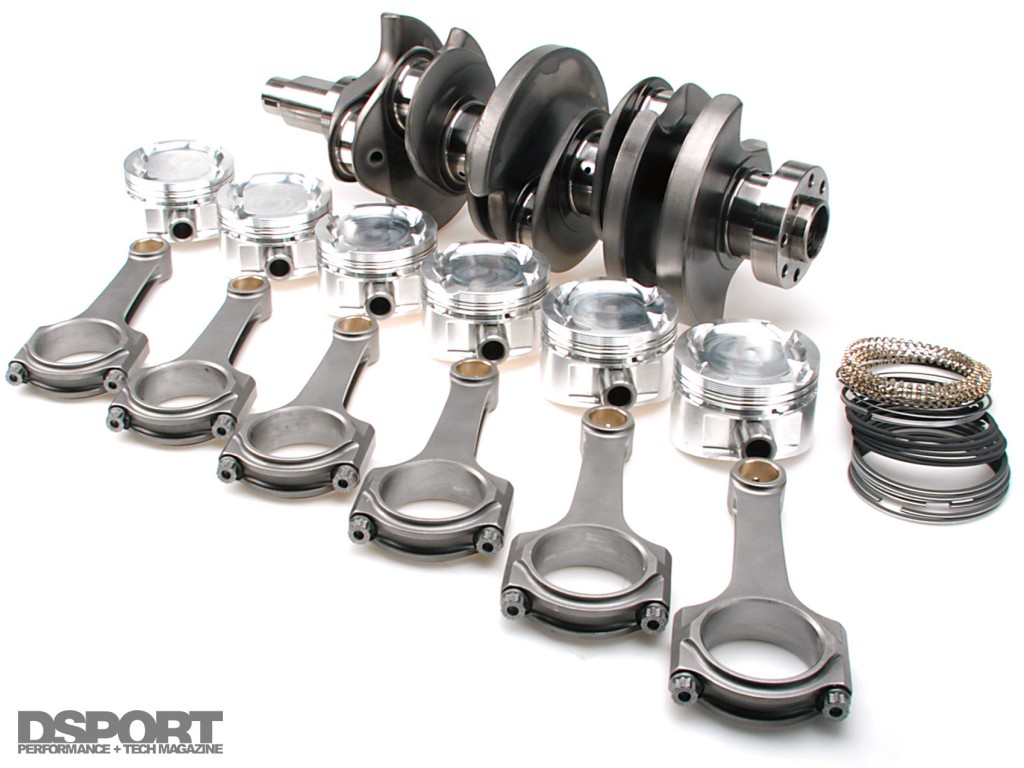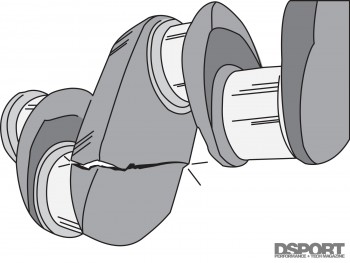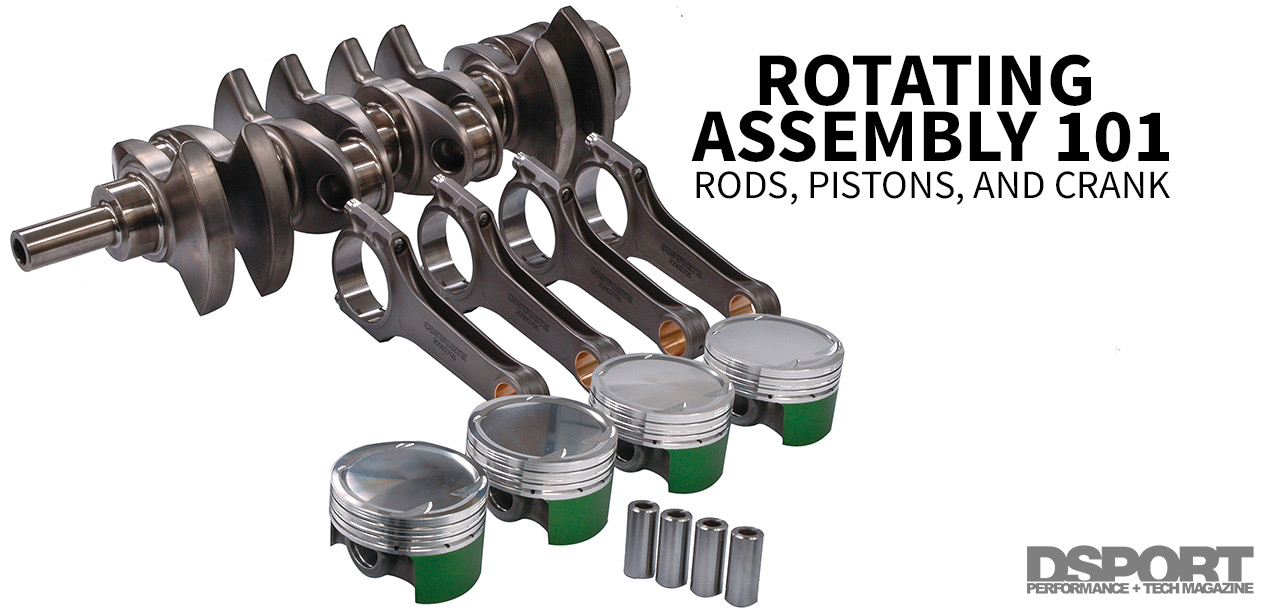Stroker Considerations
If adding displacement is on the agenda, a stroker crankshaft can help to deliver some serious gains. The percent increase in displacement is directly proportional to the percent increase in stroke. In the case of our SR23 build, we went from an 86mm to 91mm stroke. This 5.8-percent increase in stroke resulted in a 5.8-percent increase in displacement over the factory crank. The bore increase from 86mm to 89.5mm resulted in an 8.3-percent increase in displacement, on its own. Combined, the effects of the bore and stroke increases are magnified to provide a 14.6-percent increase in displacement (1,998cc to 2,290cc). Increased displacement is one of the advantages of an increase in stroke. Stroker engines will also have a shortened connecting rod length-to-stroke ratio. This reduction leads to improved cylinder filling at the beginning of each intake stroke. This will lead to improved low-end and mid- range power and torque production. In some cases, it may also lead to improved power at higher engine speeds too.
Increasing the stroke of an engine also has its tradeoffs. First, the piston and/or connecting rods must be matched to work with the increase in stroke. Normally this requires moving the piston pin to a higher location in the piston and/or reducing the center-to-center length of the connecting rod. Second, many stroker crankshafts require “relieving” of the block to accommodate the longer stroke. This process involves grinding away at the block to make clearance for the counterweights or connecting rods that would otherwise interfere at the elongated stroke. Third, peak engine RPM, as limited by maximum-desired mean piston speeds, will be reduced.
If 9,000 RPM produces 5,000 feet-per-minute maximum mean piston speeds on a 86.4mm stroke, increasing the stroke by 10-percent to 95mm will reduce the redline to 8,000 RPM (for the same 5,000 feet-per-minute mean piston speed). Fourth, an increase in stroke also increases the side loading of the pistons against the bores during the crankshaft’s rotation. As a result, cylinder bore wear increases too. Based on the pros and cons, a stroker crankshaft may or may not be the right choice for you.
| Simplified Displacement Calculators |
|---|
| 4-cyl (cc) = .0031414 x stroke (mm) x bore (mm) x bore (mm) |
| 6-cyl (cc) = .0047123 x stroke (mm) x bore (mm) x bore (mm) |
| 8-cyl (cc) = .0062831 stroke (mm) x bore (mm) x bore (mm) |
| Simplified Displacement Calculators |
| Original RB26DETT; 6 cylinder, Bore=86.0mm, Stroke=73.7mm |
| 6-cyl (cc) = .0047123 x 73.7 x 86.0 x 86.0 = 2568.6cc |
| HKS “2.8-liter” Stroker Kit; 6 cylinder, Bore=87.0mm, Stroke=77.7mm |
| 6-cyl (cc) = .0047123 x 77.7 x 87.0 x 87.0 = 2771.4cc |
| Displacement increase= 2771.4 – 2568.6 = 202.8cc |
–
 Stroking your engine involves a piston, rod and crankshaft selection that will work together the way you intend it to. Many manufacturers make complete drop-in stroker kits.
Stroking your engine involves a piston, rod and crankshaft selection that will work together the way you intend it to. Many manufacturers make complete drop-in stroker kits.
Happy Harmonics
When an engine’s power output is increased, the supporting systems also need to be enhanced to avoid engine failure. Aside from the obvious lubrication and cooling needs, an engine also relies on a harmonic damper bolted to the crankshaft in order to provide reliability and longevity.
 When a piston and corresponding connecting rod begins to cycle the crankshaft at one end, the crankshaft twists slightly as the mass farther away from the segment being pushed catches up. As a crankshaft spins at several thousand RPM, one segment of the crankshaft is being pushed by the combustion while another section is working against the compression stroke. Although a crankshaft seems like a very rigid component, it does flex under the varying forces. Each rotating assembly has its own natural frequency much like a tuning fork. Aspects such as crankshaft material, engine stroke, flywheel mass and bearing dimensions determine the natural frequency of a rotating assembly. When reached, the natural frequency causes the vibrations through the crankshaft to be intensely amplified. Vibrations at an item’s natural frequency do the most damage as they match the structural composition of what it is traveling through. Remember the science video of a crystal glass exploding into pieces as it was exposed to its own natural frequency? While a crankshaft won’t exactly fly apart as easily as a wine glass, it is still far from indestructible. Harmonics at the rotating assembly’s natural frequency will fatigue the metal, breaking down the tensile strength of the crankshaft and potentially leading to cracks. These vibrations also damage components along the crankshaft such as bearings and the oil pump.
When a piston and corresponding connecting rod begins to cycle the crankshaft at one end, the crankshaft twists slightly as the mass farther away from the segment being pushed catches up. As a crankshaft spins at several thousand RPM, one segment of the crankshaft is being pushed by the combustion while another section is working against the compression stroke. Although a crankshaft seems like a very rigid component, it does flex under the varying forces. Each rotating assembly has its own natural frequency much like a tuning fork. Aspects such as crankshaft material, engine stroke, flywheel mass and bearing dimensions determine the natural frequency of a rotating assembly. When reached, the natural frequency causes the vibrations through the crankshaft to be intensely amplified. Vibrations at an item’s natural frequency do the most damage as they match the structural composition of what it is traveling through. Remember the science video of a crystal glass exploding into pieces as it was exposed to its own natural frequency? While a crankshaft won’t exactly fly apart as easily as a wine glass, it is still far from indestructible. Harmonics at the rotating assembly’s natural frequency will fatigue the metal, breaking down the tensile strength of the crankshaft and potentially leading to cracks. These vibrations also damage components along the crankshaft such as bearings and the oil pump.
If no crankshaft is safe from vibrations, how is it that engines don’t fail shortly after construction? The answer is because every automotive manufacturer incorporates a form of harmonics damper on the crank pulley. These units typically utilize an inertia ring sandwiching an elastomer tuned to neutralize vibrations at the engine’s natural frequency. As a crankshaft transmits vibrations to the inner hub of the damper, the inertia of the spinning outer ring suspended by the elastomer counteracts the vibrations. Factory- equipped harmonic dampers do a fine job of eliminating engine-damaging frequencies when the engine is stock. However, if a rotating assembly’s properties change or power output is increased, the factory-installed harmonic damper becomes insufficient at neutralizing harmonic buildup. This has prompted a handful of manufacturers to engineer crank dampers designed for performance engines.
However, if a rotating assembly’s properties change or power output is increased, the factory-installed harmonic damper becomes insufficient at neutralizing harmonic buildup. This has prompted a handful of manufacturers to engineer crank dampers designed for performance engines.
Aftermarket import-performance damper manufacturers produce two different types of damping technology: elastomer and viscous fluid. Much like OEM dampers, elastomer units utilize a specifically-tuned rubber (or other similar material) to hold an outer inertia ring. The lag produced by the flexing elastomer between the inner hub and inertia ring produces counteracting torque to crankshaft vibrations. While a viscous-type damper produces similar vibration-counteracting torque, it relies on an inertia ring suspended by gel inside the unit. DSPORT experienced both technologies with its project cars and both succeeded in preventing failures from harmonics.


